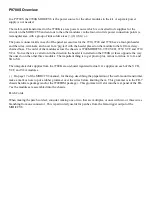
23
•
An extraction hood that fits over the top of the fluidised bath to provide a peripheral
extraction system. Any fumes entrained from above the bath are passed to the effluent
gas extract duct.
•
Ductwork to connect the fluidised bath extract duct via the various fume treatment
equipment to the input of the fume extraction fan. The ductwork should include an air
dilution tee, positioned as close as possible to the fluidised bath. The dilution tee enables
the fumes within the system to be diluted with air. The ductwork should also include a
damper valve which is normally positioned adjacent to the extraction fan. This valve
allows the extraction velocity to be reduced. In general the ductwork may be
manufactured out of galvanised mild steel; however, in installations where PVC or other
halogenated polymers are being processed, it is recommended that stainless steel
ducting is used. The ductwork should be as short as possible and contain the minimum
number of bends and horizontal runs so as to reduce the possibility of a blockage.
•
A cyclone separator should be mounted directly after the dilution tee. The cyclone
removes any fluidised medium that may be present in the extracted fumes. The
fluidization medium is collected in the cyclone collection bin from where it may be
returned to the fluidized bath.
•
In applications where the components being cleaned are contaminated by polymers
which contain inorganic pigments or fillers such as titanium oxide, of a particle size less
than 0.005mm diameter which will not be retained by the cyclone, it is recommended that
a filtration system be fitted after the cyclone.
•
In applications where the materials being treated produce acidic vapours during thermal
decomposition, it is recommended that a fume scrubber be utilised to ensure that the final
fume emission from the plant conforms to local regulations. A caustic dosing system may
also be required to ensure that the scrubbing liquid is maintained at an acceptable pH
level.
•
An extraction fan is required in all applications to provide the motive force for the exhaust.
In applications where it is not permissible to emit visible smoke from the plant or where
local regulations specify the maximum fume concentrations that may be emitted from an
exhaust stack, an afterburner maybe required. The afterburner heats the fumes to a point
where thermal incineration eliminates the visible content of the fumes while also reducing
the fume concentration.
•
Finally, an exhaust stack is required to direct the treated fumes away from the working
environment. The exhaust stack will generally be manufactured out of the same materials
as the ductwork system. However, in installations where an afterburner is fitted, the
exhaust stack should be manufactured out of insulated stainless steel.
The exact combination of fume treatment components required depends upon the application and
local conditions. Technical staff are available to discuss particular applications and offer advice as
to which combination is required. Techne are able to offer the following fume treatment
equipment:
Cyclone
Scrubber
Caustic Dosser
Extraction Fan
Afterburner
Summary of Contents for IFB-201
Page 1: ...IFB 201 OPERATOR S MANUAL...
Page 3: ...3 Spare Parts 31 Accessories 31 Circuit Diagrams 32...
Page 31: ...32 Circuit Diagrams...
Page 32: ...33...
Page 33: ...34...













































